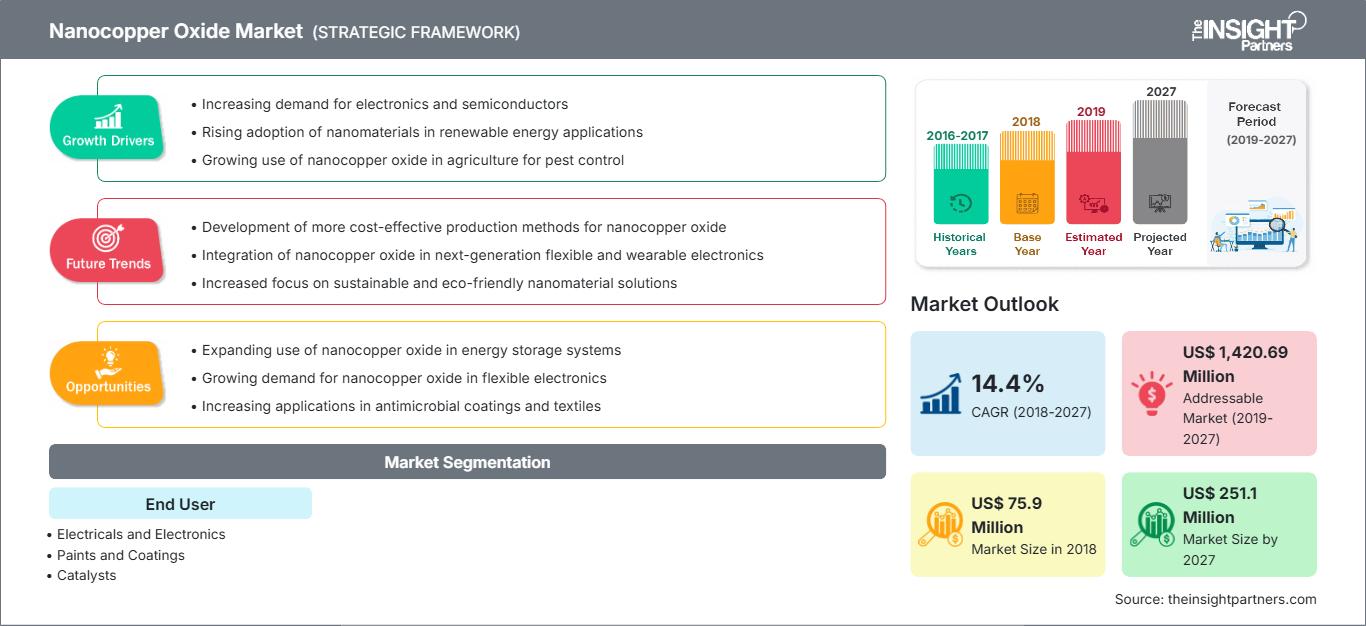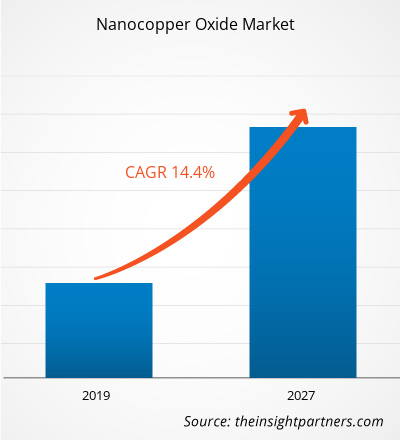[Informe de investigación] El mercado de óxido de nanocobre se valoró en US$ 75,9 millones en 2018 y se proyecta que alcance los US$ 251,1 millones para 2027; se espera que crezca a una CAGR del 14,4% entre 2019 y 2027.
El óxido de nanocobre es una nanopartícula de color rojizo o marrón negruzco que se utiliza como catalizador en la industria química. Sus diversas propiedades, como tenacidad, ductilidad, mayor resistencia y alta conductividad eléctrica, lo hacen ideal para diversas aplicaciones industriales. Además, la investigación sobre estas nanopartículas está cobrando impulso. Por lo tanto, el aumento de las actividades de I+D en los últimos años por parte de diversas instituciones, centros e industrias de investigación está impulsando el crecimiento del mercado.
Se prevé que Asia Pacífico sea la región de mayor crecimiento para el mercado de óxido de nanocobre durante el período de pronóstico. El enorme crecimiento de las actividades industriales y de infraestructura es la principal razón del crecimiento del mercado de óxido de nanocobre en Asia Pacífico. Algunas de las principales economías de la región, como China e India, son favorables para las actividades de producción. Por lo tanto, para satisfacer la creciente demanda, numerosas empresas nuevas están entrando en el mercado regional. Además, el fuerte crecimiento en numerosos sectores, como los semiconductores, la construcción y la energía, aumentará la demanda de productos eléctricos, pinturas y recubrimientos en los próximos años. Se espera que esto tenga un impacto positivo en el crecimiento del mercado de óxido de nanocobre en Asia Pacífico durante el período de pronóstico.
Personalice este informe según sus necesidades
Obtendrá personalización en cualquier informe, sin cargo, incluidas partes de este informe o análisis a nivel de país, paquete de datos de Excel, así como también grandes ofertas y descuentos para empresas emergentes y universidades.
Mercado de óxido de nanocobre: Perspectivas estratégicas

-
Obtenga las principales tendencias clave del mercado de este informe.Esta muestra GRATUITA incluirá análisis de datos, desde tendencias del mercado hasta estimaciones y pronósticos.
Impacto de la pandemia de COVID-19 en el mercado de óxido de nanocobre
El brote de COVID-19 afectó negativamente a las economías e industrias de varios países debido a confinamientos, restricciones de viaje y cierres de negocios. La industria química y de materiales se encuentra entre las industrias más importantes que sufren graves interrupciones, como restricciones en la cadena de suministro y el cierre de plantas de producción. El cierre de diferentes plantas y fábricas en varios países interrumpió las cadenas de suministro globales e impactó negativamente las ventas de las industrias eléctrica, de pinturas y recubrimientos. El consumo de óxido de nanocobre también se vio afectado por la disminución de la demanda de las industrias de uso final. Varias empresas ya han anunciado posibles retrasos en las entregas de productos y una caída en las ventas futuras. Sin embargo, se ha flexibilizado la situación de las restricciones y las actividades de fabricación con la introducción de las campañas de vacunación.
Perspectivas del mercado
Aumento del consumo de óxido de nanocobre en aplicaciones biomédicas
Las nanopartículas de óxido metálico presentan una estructura única, características redox y catalíticas, una gran área superficial, mejor estabilidad mecánica y biocompatibilidad. Por lo tanto, diversas nanopartículas de óxido metálico han despertado un interés considerable en aplicaciones de terapia biomédica, bioimagen y biosensores. La síntesis de nanopartículas de óxido de cobre con mayor tamaño y características deseables se ha convertido en el principal área de impulso de la industria biomédica. En el ámbito biomédico, la detección constituye una importante área de aplicación de los nanomateriales debido a su tamaño nanométrico y sus extraordinarias características fisicoquímicas. Sin embargo, con los avances tecnológicos, se ha producido un cambio de paradigma hacia una combinación teranóstica de características de detección y terapéuticas en una única plataforma. Además, las nanopartículas de óxido de cobre se utilizan eficazmente para la identificación de entornos in vivo e in vitro. En el futuro, las nanopartículas de CuO para aplicaciones biomédicas podrían incluir la identificación y detección de enfermedades o virus en el cuerpo humano. Por ejemplo, varios estudios indican que las nanopartículas de CuO pueden utilizarse para la detección del virus de la gripe H1N1. Además, una de las innovaciones más interesantes en la industria médica es el uso de sábanas que contienen nanopartículas de CuO, ya que reducen el riesgo de infecciones microbianas en los hospitales. Asimismo, el uso de nanopartículas de CuO en fundas de almohadas y ropa de cama se ha asociado con una mejor apariencia de la piel del rostro y los pies. Por lo tanto, con el aumento de la inversión en I+D, junto con los avances en la industria biomédica, se espera que la demanda de nanoóxido de cobre aumente en los próximos años.
Información basada en el usuario final
Por usuario final, el mercado de nanoóxido de cobre se segmenta en productos eléctricos y electrónicos, pinturas y recubrimientos, catalizadores, almacenamiento de energía, entre otros. Este segmento posee la mayor cuota de mercado. Se espera que este segmento registre la mayor tasa de crecimiento anual compuesta (TCAC) durante el período de pronóstico. Los nanorrecubrimientos se utilizan en pinturas y recubrimientos para sellar, proteger o colorear superficies sólidas. Para ello, los pigmentos, como las nanopartículas sólidas, desempeñan un papel fundamental y se han utilizado desde hace milenios. Actualmente, se utilizan nanomateriales para aumentar la eficacia y aportar nuevas funcionalidades a las pinturas. Ya existen numerosas pinturas nanomejoradas en el mercado. Recientemente, la demanda de nanoóxido de cobre ha experimentado un ligero aumento, debido a la creciente demanda de pinturas y recubrimientos innovadores en la industria automotriz. Por lo tanto, el crecimiento de la industria automotriz impulsa el mercado de pinturas y recubrimientos, lo que, a su vez, impulsa el crecimiento del mercado de nanoóxido de cobre.
Los actores clave que operan en el mercado global de óxido de nanocobre son American Elements; Hongwu International Group Ltd.; Inframat Corporation; nanoComposix; Nanoshel LLC; Nanostructured & Amorphous Materials, Inc.; PlasmaChem GmbH; SkySpringNanomaterials Inc.; Strem Chemicals Inc.; y US Research Nanomaterials, Inc. Los principales actores del mercado se centran en estrategias como fusiones y adquisiciones y lanzamientos de productos para aumentar la presencia geográfica y la base de consumidores a nivel mundial.
Perspectivas regionales del mercado de óxido de nanocobre
Los analistas de The Insight Partners han explicado detalladamente las tendencias regionales y los factores que influyen en el mercado de óxido de nanocobre durante el período de pronóstico. Esta sección también analiza los segmentos y la geografía del mercado de óxido de nanocobre en América del Norte, Europa, Asia Pacífico, Oriente Medio y África, y América del Sur y Central.
Alcance del informe de mercado de óxido de nanocobre
| Atributo del informe | Detalles |
|---|---|
| Tamaño del mercado en 2018 | US$ 75,9 millones |
| Tamaño del mercado en 2027 | US$ 251,1 millones |
| CAGR global (2018-2027) | 14,4% |
| Datos históricos | 2016-2017 |
| Período de pronóstico | 2019-2027 |
| Segmentos cubiertos |
Por el usuario final
|
| Regiones y países cubiertos |
América del norte
|
| Líderes del mercado y perfiles de empresas clave |
|
Densidad de actores del mercado de óxido de nanocobre: comprensión de su impacto en la dinámica empresarial
El mercado de óxido de nanocobre está creciendo rápidamente, impulsado por la creciente demanda del usuario final debido a factores como la evolución de las preferencias de los consumidores, los avances tecnológicos y un mayor conocimiento de los beneficios del producto. A medida que aumenta la demanda, las empresas amplían su oferta, innovan para satisfacer las necesidades de los consumidores y aprovechan las tendencias emergentes, lo que impulsa aún más el crecimiento del mercado.

- Obtenga una descripción general de los principales actores clave del mercado de óxido de nanocobre
Informe destacado
- Tendencias progresivas de la industria en el mercado de óxido de nanocobre para ayudar a los actores a desarrollar estrategias efectivas a largo plazo.
- Estrategias de crecimiento empresarial adoptadas por los mercados desarrollados y en desarrollo
- Análisis cuantitativo del mercado de 2017 a 2027
- Estimación de la demanda mundial del mercado de óxido de nanocobre
- Análisis de Porter para ilustrar la eficacia de los compradores y proveedores que operan en la industria
- Desarrollos recientes para comprender el escenario del mercado competitivo
- Tendencias y perspectivas del mercado, así como factores que impulsan y restringen el crecimiento del mercado.
- Asistencia en el proceso de toma de decisiones destacando las estrategias de mercado que sustentan el interés comercial, lo que conduce al crecimiento del mercado.
- El tamaño del mercado del óxido de nanocobre en varios nodos
- Descripción detallada y segmentación del mercado, así como la dinámica de la industria.
- Tamaño del mercado en diversas regiones con oportunidades de crecimiento prometedoras
- Análisis histórico (2 años), año base, pronóstico (7 años) con CAGR
- Análisis PEST y FODA
- Tamaño del mercado, valor/volumen: global, regional y nacional
- Industria y panorama competitivo
- Conjunto de datos de Excel
Informes recientes
Informes relacionados
Testimonios
Razón para comprar
- Toma de decisiones informada
- Comprensión de la dinámica del mercado
- Análisis competitivo
- Información sobre clientes
- Pronósticos del mercado
- Mitigación de riesgos
- Planificación estratégica
- Justificación de la inversión
- Identificación de mercados emergentes
- Mejora de las estrategias de marketing
- Impulso de la eficiencia operativa
- Alineación con las tendencias regulatorias






















 Obtenga una muestra gratuita para - Mercado de óxido de nanocobre
Obtenga una muestra gratuita para - Mercado de óxido de nanocobre